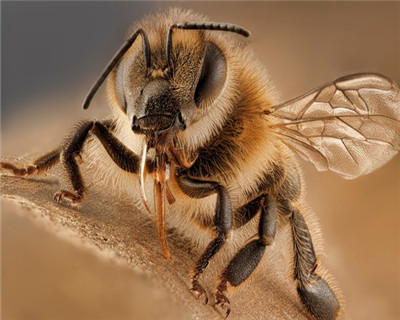(单词翻译:单击)
听力文本
This is Scientific American's 60-second Science. I'm Karen Hopkin.
If there's one thing we know about viruses, it's that they love to spread. The novel coronavirus is happy to use us humans as its host. Other viruses fancy honeybees. But like us, bees fight back.
In the case of one particular virus, called Israeli acute paralysis virus, a study shows that honeybees actually use a form of social distancing to prevent transmitting the infection within their own colony. Of course, not to be outdone, the virus manipulates the bees in a way that spreads the infection to the colony next door. The study is in the Proceedings of the National Academy of Sciences.
Honeybees live in large communities that contain tens of thousands of related individuals in close quarters. So researchers got to wondering, How can bees keep infections from spreading like wildfire?
While a graduate student at the University of Illinois at Urbana-Champaign, Tim Gernat developed an automated system for tracking the behavior of thousands of individual bees. And he watched what happened when he introduced infected bees into the hive.
Entomologist Adam Dolezal, who worked with Gernat, describes what they saw.
"We found in this study that within their own colony context, when they are interacting with their nest mates—usually their sisters—infected bees experience fewer contact behaviors—fewer mouth-to-mouth feeding contacts—than bees who are not infected."

The researchers also saw the same sort of social avoidance when, instead of infecting the bees with a virus, they artificially activated the bees' immune system. So the behavior isn't driven by the virus but by the bees' own immune response—which Dolezal says makes sense. If honeybees are going to protect their colony and their queen from disease, sick bees need to keep their feelers to themselves.
"They have to. They live in these really large colonies, where everybody's touching each other all the time; they're all closely related. I joke that honeybees have been doing social distancing for millions of years."
At the same time, bees are under no pressure to keep infections from spreading to other colonies. And that's where the virus gains the upper hand. Amy Geffre, who worked on the project as a graduate student, found that the guard bees from other colonies were actually less aggressive toward incoming infected bees than they were to uninfected bees. As a result ...
"The infected bees are accepted into the colony at about twice the rate of control bees or immunostimulated bees."
The virus, it seems, alters the chemicals that bees use to communicate who they are and where they're from.
"And so we think that one way that the virus could be gaining entry to these other colonies is by changing the bees' physiology in a way to make it more acceptable to other colonies' guard bees."
That's bad news for beekeepers, who tend to keep tens or even hundreds of hives right next to one another.
"It's a really ripe situation for bees to be able to move between colonies relatively easily and bring pathogens and parasites along with them."
Seems ya gotta carefully mind your beeswax—and keep kept colonies healthily socially distanced.
For Scientific American's 60-second Science. I'm Karen Hopkin.
参考译文
这里是科学美国人——60秒科学。我是凯伦·霍普金。
如果说我们对病毒有一点了解的话,那就是它们喜欢传播。这种新型冠状病毒乐于用我们人类作为宿主。其它病毒喜欢蜜蜂。但和我们一样,蜜蜂也会反击。
以一种名为以色列急性麻痹病毒的特殊病毒为例,一项研究表明,蜜蜂实际上利用一种社交距离的形式来防止在自己的蜂群内传播感染。当然,病毒也不甘示弱,它会以一种将感染传播到隔壁蜂群的方式来操纵蜜蜂。这项研究发表在《美国国家科学院院刊》上。
蜜蜂生活在由数万个相关个体组成的大群落中。因此研究人员想知道,蜜蜂如何阻止感染像野火一样蔓延?
蒂姆·格纳特在伊利诺伊大学香槟分校攻读研究生期间开发了一个自动系统,用于追踪数千只蜜蜂个体的行为。他观察了当他将受感染蜜蜂引入蜂巢时发生的事情。
昆虫学家亚当·多莱扎尔与格尔纳特共事,他描述了他们看到的情况。
“我们在这项研究中发现,在它们自己的群体环境中,当它们与巢穴同伴(通常是它们的姐妹)互动时,受感染蜜蜂经历的接触行为和口对口喂食接触都要少于未受感染蜜蜂。
研究人员还发现了同样的社交回避,他们没有用病毒感染蜜蜂,而是人为激活蜜蜂的免疫系统。因此,这种行为并非由由病毒引起,而是由蜜蜂自身的免疫反应所引起,多莱扎尔称这是有道理的。如果蜜蜂要保护它们的蜂群和蜂王不受疾病的侵害,生病的蜜蜂就必须将触角藏在自已的身体里。
“它们必须这样做。它们生活在非常大的蜂群中,每个人都在互相接触;它们都有着密切的联系。我开玩笑说,蜜蜂数百万年来一直在保持社交距离。”
与此同时,蜜蜂没有压力来防止感染扩散到其他蜂群。这就是病毒占上风的地方。作为研究生参与这个项目的艾米·格弗尔发现,其他蜂群的守卫蜂实际上对入侵的受感染蜜蜂的攻击性比对未受感染蜜蜂的攻击性要小。结果……
“受感染蜜蜂进入蜂群的几率大约是对照组或免疫刺激蜜蜂的两倍。”
这种病毒似乎改变了蜜蜂产出的、用于交流身份和来自何处的化学物质。
“因此,我们认为病毒进入其他蜂群的一种方式是改变蜜蜂的生理机能,使其更容易被其他蜂群的守卫蜂所接受。”
这对养蜂人来说是个坏消息,他们往往会将数十个甚至数百个蜂箱紧挨着放。
“蜜蜂能够相对容易地在蜂群间移动,并携带病原体和寄生虫,这是一个非常成熟的情况。”
看来你得少管闲事——让种群保持健康,保持社交距离。
谢谢大家收听科学美国人——60秒科学。我是凯伦·霍普金。
译文为可可英语翻译,未经授权请勿转载!
重点讲解
重点讲解:
1. fight back 反击;还击;
He ducked the first few blows then started to fight back.
他躲开最先几拳后便开始反击。
2. interact with 相互交流;相互沟通;
After initiation, the youths started to interact with the older members.
入会仪式后,这些小伙子与老成员开始互动。
3. make sense 可以理解;讲得通;
On the face of it that seems to make sense. But the figures don't add up.
乍一看,似乎讲得通,但这些数字对不起来。
4. gain the upper hand 上风;优势;有利地位;
Therefore athletes good at serves gain upper hand in the game.
因此发球技术较好的运动员在比赛中能够保住自己的发球局而占得先机。


